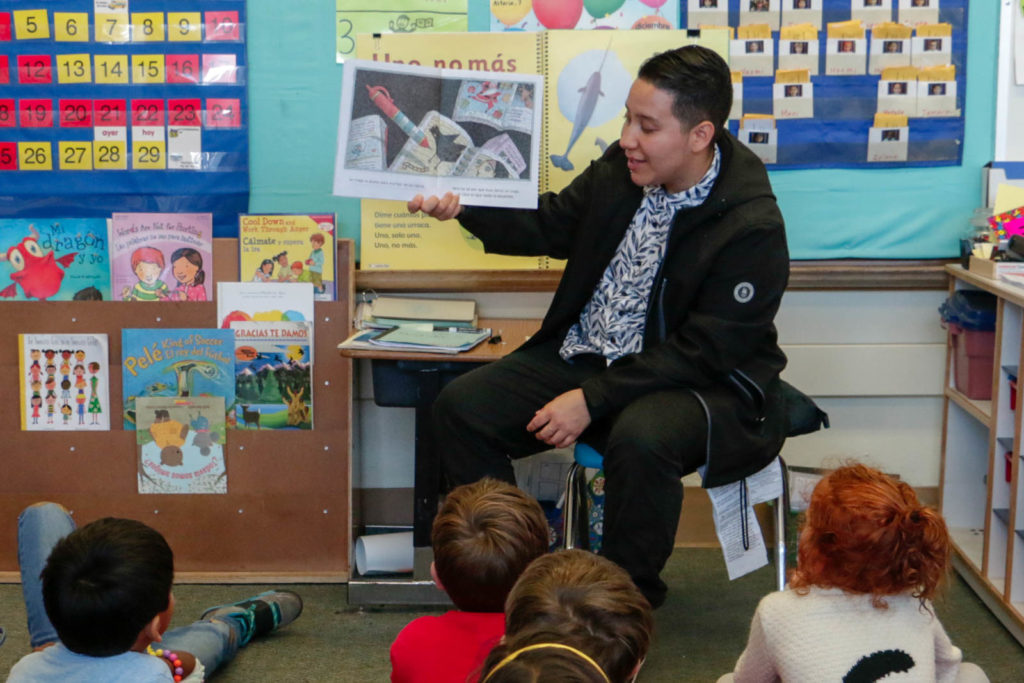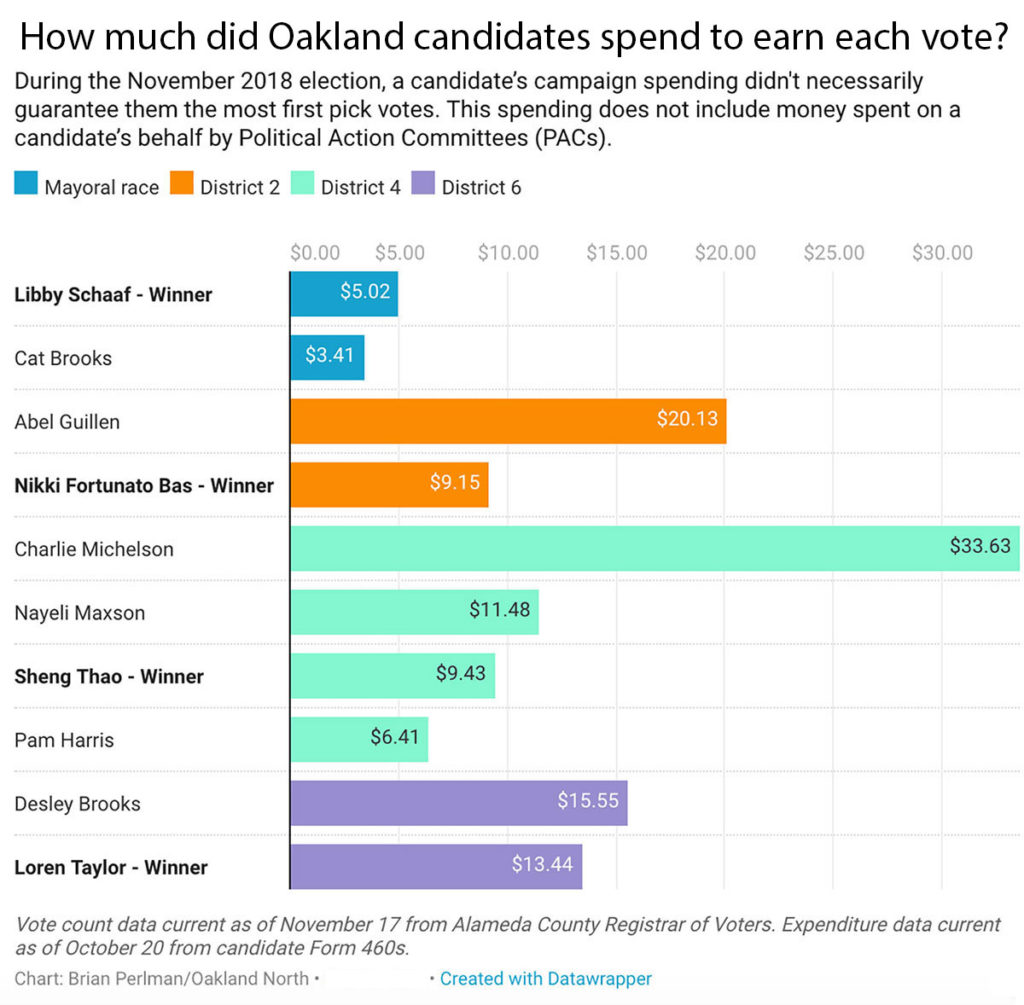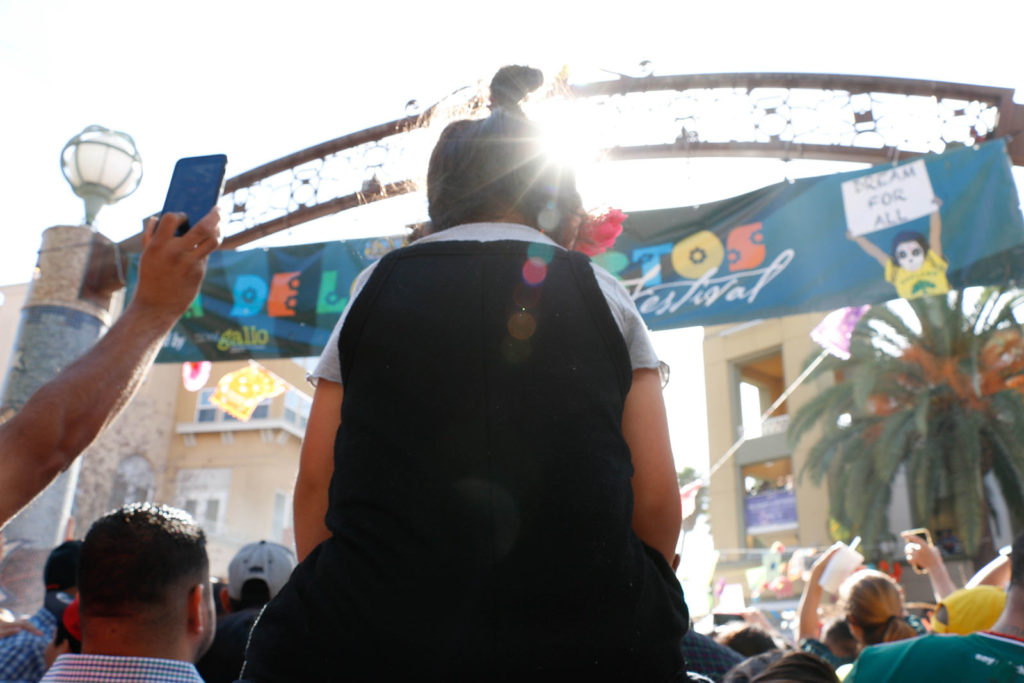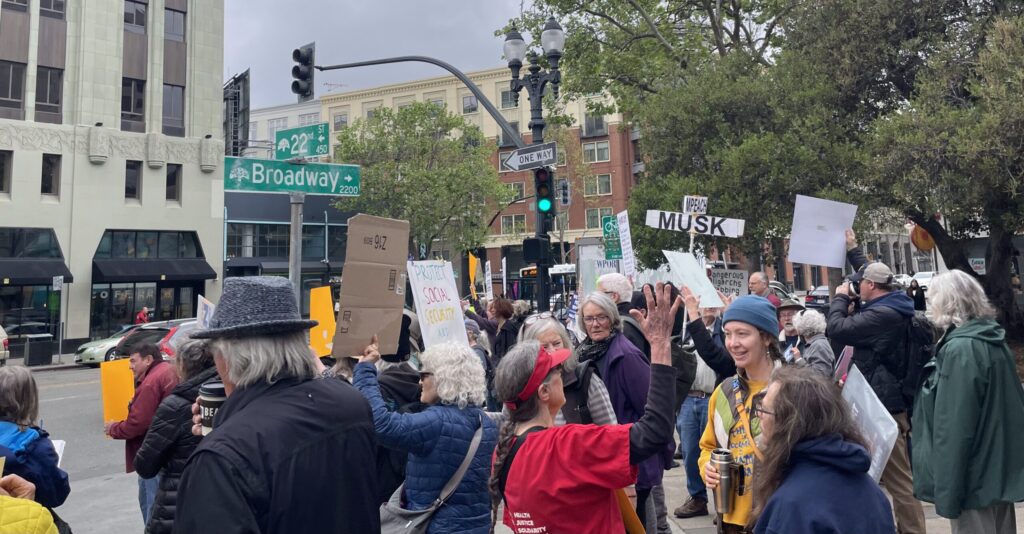
Kindergarten teacher writes bilingual children’s book on how to use gender neutral pronouns
on November 30, 2018
If the walls of Sylvia Mendez Elementary School could talk, they would speak in a sophisticated Spanglish. The long corridors are painted in two different shades of blue, a rich vibrant teal adjacent to a pastel turquoise. Towards the end of the hall, kitty-corner to the all-student restroom, is room 101, Lourdes Rivas’s kindergarten classroom.
The classroom is decorated with a variety of posters that read:
“Women are perfect.”
“We empower our people to heal our hearts.”
“We are resilient.”
“Our studies will not be banned.”
Not a single wall space is bare. Posters cards with animal figures representing the Spanish alphabet decorate the back of the room. Several multicolored Mexican serapes are placed in the area designated biblioteca de salon (classroom library). The library contains classics in Spanish such as Juan y los Frijoles Magicos (Jack and the Beanstalk) and Los Osos Bernstein (The Bernstein Bears).
Rivas walks into the classroom followed by a line of panting kindergartners coming back from recess, and asks the group to sit on a rug with rows of different colored blocks that resemble an unsolved Rubik’s cube. Once the students are seated on their assigned blocks, they begin their phonetics lesson by singing the alphabet song in Spanish. They recreate the sound letters make:
“Ah, ah, ah.”
“Mm, mm, mah, mah, mah.”
“Puh, puh, puh.”
Sylvia Mendez Elementary is a two-way immersion school, also known as dual-language, meaning that students are taught in both Spanish and English. For kindergarten teachers such as Rivas, all instructional time is in Spanish. Every year afterwards, English is incorporated incrementally by 10 percent into the classroom. By fifth grade, students are using a 50/50 ratio.
Rivas, an Oakland resident who prefers the gender-neutral pronouns they/them, is also teaching these kindergarteners about how language can be used to communicate ideas about gender. In 2016, Rivas began writing a bilingual children’s book, They Call Me Mix, as a way to introduce the concept of the gender binary to their students. The gender binary is a social construct that classifies someone’s gender based on their reproductive system, genitals, or sex. In this binary, only two genders exist: male and female. People are socialized to behave and hold characteristics of their assumed gender. Rivas thinks it’s a significant to teach young students that not all people are clearly him or her.
The Spanish language itself is very gendered. Words–including common objects and names for people–can have masculine or feminine forms. So for example, in Spanish, teacher translates to maestro (masculine) or maestra (feminine). Because Rivas does not identify with the gender binary, they use the gender-neutral version of teacher: maestre. Every year, “the kids would ask me why I have them call me maestre and I would tell them the story of what non-binary means,” says Rivas.
Rivas was inspired to write the book because, most of the time, they would explain what non-binary meant on the fly. Rivas would tell their students, “When I was born, people just decided and agreed that I was a girl and that’s actually not what you know … It’s all made up.”
According to Louise Derman-Sparks and Julie Olsen, authors of the book Anti-Bias Education for Young Children and Ourselves, by the age of 2, children begin using gender and skin color labels. By age 3, children begin to ask questions about their own and other’s racial identity, language, gender, and physical disabilities. Rivas believes children’s books are a way to facilitate conversations with children about the identities of themselves or others.
They Call Me Mix is an autobiographical account of Rivas’s life and why they use gender-neutral pronouns. The book begins with Rivas explaining how they were assigned a gender before they were born and taught to believe that gender doesn’t change or evolve. In the book, Rivas’ character ends up learning that gender evolves and coming to think of themselves as non-binary.
Because the Spanish language is so gendered, Rivas uses what they call “a variety of forms of dismantling the binary in Spanish” in their book. For example, they use the @ instead of the o or a when using a possessive noun and the pronouns elle (instead of ella). Other writers are increasingly using X at the end of Spanish words to convey the same idea. For example, the term Latinx is used to identify people of any gender. “Language is ever-evolving and it’s always changed according to the culture,” Rivas says about the use of the @ symbol.
Rivas envisions the book also being used by parents as a way to talk to their young children about gender. “A lot of people say they’re too young to have these conversations,” Rivas says, but sometimes parents simply don’t know how to talk about these things. “I think about my mom and how she had her way of doing things because she didn’t know any better. But now she does because she’s experiencing it with me and she’s trying her best to use the correct pronouns.”
In August, 2017, Rivas created a Kickstarter campaign to cover the costs of publishing the book. In the first 24 hours, Rivas raised over $2,000. By the end of the campaign, they raised $12,545. Rivas partnered with local illustrator Breena Nuñez for the book’s artwork. By late November 2018, They Call Me Mix was in its final technical review at Ingram Spark Publishing House. Once approved, printing will begin and it will be released on December 26, 2018.
Kindergarten is often the time when young children first learn behavior developmental skills as well as fundamental academic skills—they are taught how to interact with other children and how to read and write. Children’s books expose young students to both. However, Rivas feels that there are few books that reflect diverse experiences, and others reinforce negative stereotypes.
“There is a huge diversity gap in children’s books,” says Rivas. Referring to a infographic created by publisher Lee & Low Books on children’s books written by people of color, Rivas says, “Only 7 percent of the children’s books written in 2017 were by Black, Latino, and Native authors combined. There’s an even bigger gap of children’s books with queer and/or gender expansive content that were written by actual queer and trans authors.”
“My book is part of that even smaller percentage,” Rivas continues.
Rivas is not the only person who is critical of stereotypes in children’s books. For example, Skippyjon Jones is a popular children’s book about a Siamese cat who speaks with an anglicized Spanish accent wanting to become a Chihuahua. In the book, Chihuahuas are alluded to as Mexican, due to references to Mexican culture and language. But Columbia University bilingual/bicultural education associate professor Carmen M. Martinez-Roldan argues that the author uses harmful and reductive stereotypes of the Latinx community that were created by a white author based on what they assume all Latinx people are like. For example, the Chihuahuas live in a dog house that is described as an abandoned shack and are portrayed as drunk characters who enjoy fiestas, taking siestas, and exclaiming “Holy frijoles!” as they eat beans and tortillas.
Martinez-Roldan believes that these portrayals reinforce negative stereotypes of Mexicans as poor, filthy and lazy and do not convey the nuances of the Latino experience. “Because of the many differences among Latinos, in language practices, social class, country of origin, and so forth, it is not possible for a children’s book to accurately represent all Latinos as a group,” she wrote in an article called The Representation of Latinos and the Use of Spanish: A Critical Content Analysis of Skippyjon Jones. “Rather, teachers and children should have access to a variety of books that collectively represents students from various backgrounds and communities.”
Rivas likes to use They She He Me, Free to Be! and The Gender Wheel by Maya Christina Gonzalez and Ordinary People Change the World by Brad Meltzer as positive models for children’s books in their classroom.
Back in the classroom, Rivas, wearing a buzzed haircut that looks a day fresh, black khaki cargo pants and a button up with a dandelion and rose pattern, is crouching down next to a table of four to be eye-level with the students. The students are doing a worksheet activity in their desks. One of the students sucks on their thumb as they practice writing the letter “S.”
“Maestre! Maestre!” yells another student from across the room, wilding waving her hand. “Teacher! Teacher!” they switch to English with an exasperated gasp. Rivas makes eye contact with the student and motions with their finger to wait.
During the last fifteen minutes of the phonetics lesson, Rivas asks the estrellita del dia—a student who gets to help lead the class—to pick a book for them to read to the class. The student chooses one with a purple-freckled blue fish with droopy eyes on the front cover—El Pez Pucheros, or The Pout Pout Fish. The book follows the adventures of a gloomy fish with a constant pout, a puchero, and his interactions with his sea creature friends. The clam, the jellyfish, the squid, and even the octopus give the pout pout fish advice on how to turn his “daily scaly scowl … grimace and growl” into a smile.
The students cling on to every word. As if on cue, several students sing along with Rivas:
“Porque yo soy un pez puchero con cara de pesar. Voy regando mis penas por todo los lugares.”
(“I’m a pout pout fish with a pout pout face. So I spread the dreary-wearies all over the place.”)
“BLUB. BLUUUBB. BLUUUUUUBBBB!” they sing.
Every time, the BLUBBB makes several students roll with laughter.
Towards the end of the book, the fish realizes that it’s in fact a kiss kiss fish, not a pout pout fish. At this moment, Rivas switches to English and asks the students, “Wait, what should the pout pout fish have done before he kissed all the other fishes?”
“Eeeewww” says a child who can’t get over the fish kissing another fish.
“Ask for permission!” says a student sitting in the last row.
“Yeah, I wouldn’t like it if a stranger kissed me on the cheek either,” says a third student.
This time, instead of using books to explore language and gender, Rivas just turned an ordinary children’s book into a small lesson about not touching people without their permission.
When They Call Me Mix is published, Rivas plans to read it to their students, too. “I wrote the book so I can use it in my classroom to explain why I use non-binary pronouns,” they say. Rivas hopes kids will learn to think imaginatively about gender and that it will teach them the practice of asking people for their preferred gender pronouns.
“Even if the language itself creates a barrier, such as the Spanish language, we can always find a way to make it work,” says Rivas.
You can find more information about They Call Me Mix on Instagram @theycallmemix.
2 Comments
Oakland North welcomes comments from our readers, but we ask users to keep all discussion civil and on-topic. Comments post automatically without review from our staff, but we reserve the right to delete material that is libelous, a personal attack, or spam. We request that commenters consistently use the same login name. Comments from the same user posted under multiple aliases may be deleted. Oakland North assumes no liability for comments posted to the site and no endorsement is implied; commenters are solely responsible for their own content.

Oakland North
Oakland North is an online news service produced by students at the UC Berkeley Graduate School of Journalism and covering Oakland, California. Our goals are to improve local coverage, innovate with digital media, and listen to you–about the issues that concern you and the reporting you’d like to see in your community. Please send news tips to: oaklandnorthstaff@gmail.com.






Lourdes, this sounds like it will be a great book for use in classrooms and at home.
I like that you pronounce Mx as ‘mix,’ that’s also how I say it. A few years ago i wrote a major article about Mx which might be helpful to you in your ongoing advocacy for gender neutral language.
The article deals with many scenarios, based on my long experience of using it (since 2002), and seeks to clarify many misunderstandings about Mx. I hope you will find it useful.
http://www.mixmargaret.com/about-mx-with-miss-mrs-mr-ms-and-the-singular-they.html
[…] https://oaklandnorth.net/2018/11/30/kindergarten-teacher-writes-bilingual-childrens-book-on-how-to-u… […]